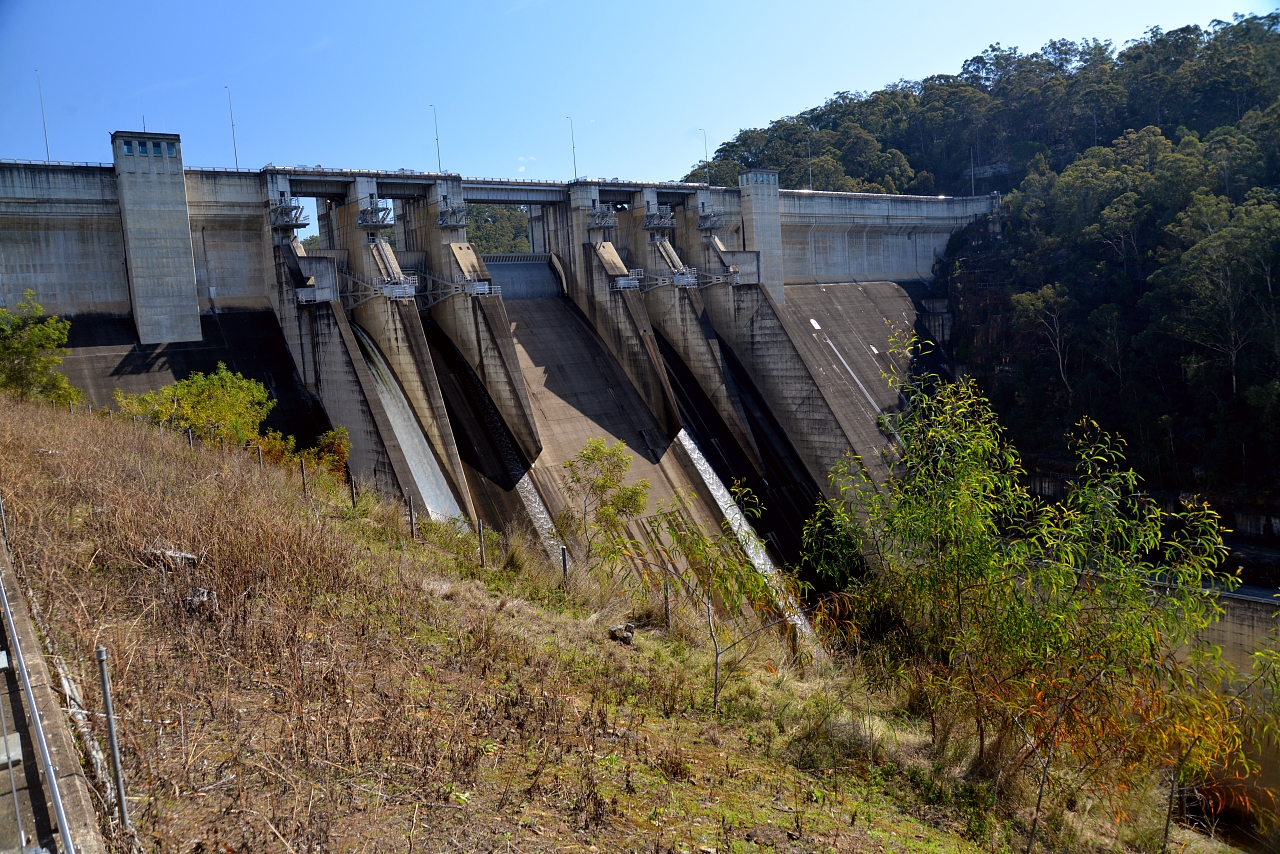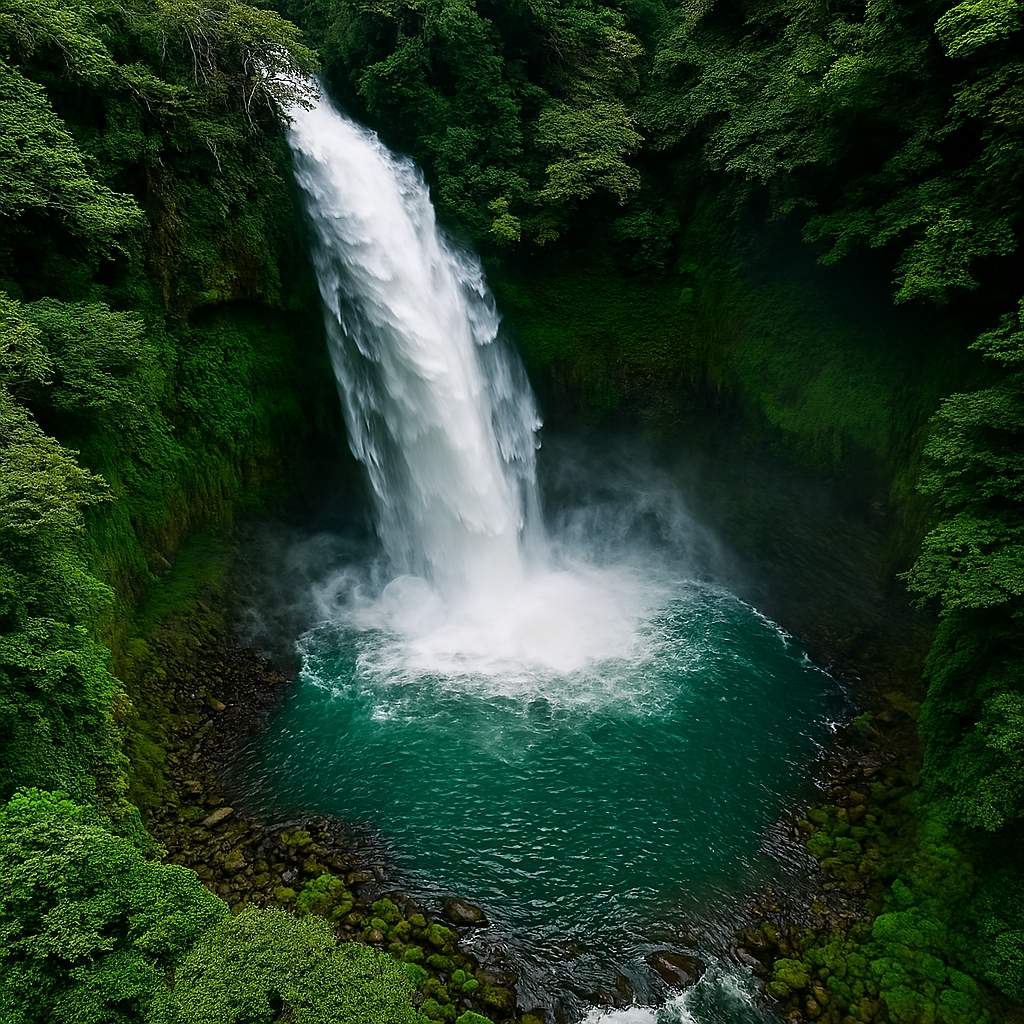Warragamba Dam – Australia’s Largest Urban Water Supply System
Warragamba Dam – A Monument to Water Security For 65 Years
Warragamba Dam was officially opened on 14 October 1960. It was built to secure Sydney’s growing demand for clean, reliable drinking water. The dam remains the largest urban water supply reservoir in Australia. It holds approximately four times the volume of Sydney Harbour when full. Construction began in 1948 and took twelve years to complete. The dam was built on the Warragamba River, a tributary of the Nepean River, in the Blue Mountains region.
Its location was chosen for its deep gorge and natural topography, ideal for water storage. The project was a response to post-war population growth and industrial expansion. Engineers designed the dam to withstand extreme weather and seismic activity. It became a symbol of modern infrastructure and national pride. The dam transformed regional hydrology, ecology, and urban planning. Today, it supplies about 80% of Greater Sydney’s drinking water. Warragamba Dam is more than a reservoir — it is a system of engineering, ecology, and public trust.
Powerful Warragamba Dam – 65 Years of Water Security – Photos By Mike Fernandes

Purpose and Planning – Why Warragamba Was Built
The decision to build Warragamba Dam was driven by water scarcity and urban expansion. Sydney’s population had doubled between 1900 and 1940. Existing reservoirs such as Prospect and Cataract were no longer sufficient. Engineers and planners sought a long-term solution to secure water for domestic, industrial, and agricultural use. The Warragamba River offered a deep gorge and high rainfall catchment. Planning began in the 1940s with hydrological surveys and geological assessments.
The site was selected for its natural containment and proximity to Sydney. The dam was designed to store over 2,000 gigalitres of water. It would also regulate river flow and reduce flood risk downstream. The project was approved by the NSW Government in 1946. Warragamba was envisioned as a central node in Sydney’s water infrastructure. It would connect to pipelines, filtration plants, and urban reservoirs. The dam was also intended to support future growth and climate variability. Planning emphasized durability, scalability, and ecological containment. Warragamba was built to last — and to lead.
Drivers Behind Warragamba Dam Construction
| Factor | Description | Impact on Planning |
|---|---|---|
| Population Growth | Rapid urban expansion in Sydney | Increased demand for water infrastructure |
| Existing Shortages | Limited capacity of older reservoirs | Necessitated large-scale solution |
| Hydrological Suitability | High rainfall and deep gorge at site | Ideal for long-term water storage |
| Flood Control | Seasonal flooding of Nepean River | Required regulation and containment |
| Strategic Location | Proximity to Sydney and transport networks | Enabled efficient distribution |
Engineering and Construction – How the Dam Was Built
Warragamba Dam was constructed using cyclopean masonry, a technique involving large interlocked stone blocks. The dam wall stands 142 metres high and stretches 351 metres across the gorge. It was built on a foundation of sandstone and shale, reinforced with concrete. Construction began in 1948 and involved over 1,800 workers. Materials were sourced locally, including stone from nearby quarries. The dam required over 1 million tonnes of concrete and stone.
A temporary diversion tunnel was built to reroute the river during construction. Workers used cableways and cranes to position blocks and pour concrete. The site operated around the clock for over a decade. Safety protocols were developed to manage high-risk tasks and heavy machinery. The dam wall was completed in stages, with constant geological monitoring. Filtration galleries and spillways were added to manage overflow and pressure. The final structure was tested for seismic and hydraulic resilience. Warragamba became a benchmark for dam engineering in Australia. Its construction marked a turning point in national infrastructure capability.
Key Engineering Features of Warragamba Dam
| Feature | Description | Purpose |
|---|---|---|
| Cyclopean Masonry | Large stone blocks interlocked with concrete | Structural strength and durability |
| Diversion Tunnel | Temporary rerouting of river flow | Enabled dry construction of dam wall |
| Spillway System | Channels for excess water release | Prevents overflow and structural damage |
| Filtration Galleries | Internal tunnels for water quality monitoring | Ensures safe drinking water |
| Seismic Reinforcement | Structural design for earthquake resistance | Protects infrastructure and population |
Hydrological Transformation – Reshaping the River System
Warragamba Dam fundamentally altered the hydrology of the Hawkesbury-Nepean catchment. Before construction, the Warragamba River flowed freely through a deep gorge, feeding downstream wetlands and floodplains. The dam created Lake Burragorang, submerging over 2,000 hectares of valley floor. This artificial reservoir changed flow velocity, sediment transport, and seasonal variability. Natural flood pulses were suppressed, reducing nutrient delivery to downstream ecosystems.
The river’s temperature and oxygen levels also shifted due to deep water releases. These changes affected aquatic species adapted to dynamic conditions. Hydrological connectivity between upstream and downstream habitats was disrupted. Wetlands that relied on seasonal inundation began to dry out. The dam introduced a permanent water body where none had existed, altering evaporation rates and local climate. Groundwater recharge patterns were modified by the reservoir’s presence. Warragamba’s hydrology became engineered, not organic. While water security improved, ecological rhythms were interrupted. The dam turned a living river into a regulated system. Hydrology became infrastructure.

Hydrological Changes Caused by Warragamba Dam
| Parameter | Pre-Dam Condition | Post-Dam Condition |
|---|---|---|
| Flow Variability | Seasonal floods and droughts | Regulated, consistent flow |
| Sediment Transport | Natural erosion and deposition | Reduced downstream sediment load |
| Temperature Profile | Surface-driven thermal cycles | Cold, deep-water releases |
| Floodplain Inundation | Regular wetting of lowlands | Suppressed flood pulses |
| Groundwater Recharge | Rain-fed and seasonal | Altered by reservoir pressure |
Environmental Impact – Submersion and Displacement
The creation of Lake Burragorang submerged vast tracts of forest, farmland, and cultural sites. Over 100 square kilometres of land were permanently flooded. This included eucalyptus woodlands, sandstone escarpments, and fertile valleys. The dam displaced wildlife, disrupted migration corridors, and fragmented habitats. Species such as wallabies, wombats, and lyrebirds lost breeding grounds and feeding zones. Aquatic ecosystems were replaced by deep, still water with different chemistry and temperature. The transformation was rapid and irreversible.
Soil profiles were buried, and vegetation drowned. The dam also altered fire regimes by removing flammable undergrowth and changing moisture levels. Carbon release from decomposing vegetation contributed to greenhouse gas emissions. The environmental cost was significant, though underreported at the time. Restoration was not part of the original plan. The dam prioritized human needs over ecological continuity. Today, environmental flows are being reconsidered to mitigate some of these impacts. Warragamba’s legacy includes both water security and ecological loss.
Ecological Consequences of Lake Burragorang
| Impact Type | Description | Affected Systems |
|---|---|---|
| Habitat Submersion | Permanent flooding of terrestrial zones | Forests, grasslands, riparian corridors |
| Species Displacement | Loss of breeding and feeding grounds | Mammals, birds, reptiles |
| Vegetation Loss | Drowning of native flora | Eucalyptus, acacia, understory plants |
| Soil Burial | Disruption of nutrient cycles | Topsoil, microbial communities |
| Fire Regime Shift | Moisture increase and fuel reduction | Bushfire patterns and intensity |

Biodiversity Shifts – From Dynamic to Static
Warragamba Dam reshaped biodiversity in the region. Dynamic riverine ecosystems were replaced by static reservoir conditions. Species adapted to flowing water struggled to survive. Fish such as Australian bass and freshwater eels lost spawning routes. Amphibians dependent on seasonal wetlands declined. Invasive species, including carp and mosquito fish, thrived in the new conditions. The reservoir created deep, low-oxygen zones unsuitable for many native organisms. Bird populations shifted from riparian specialists to generalist species. Biodiversity became homogenized, with fewer ecological niches.
The dam also interrupted pollination networks by fragmenting plant communities. Genetic isolation increased as populations were cut off from one another. Biodiversity loss was gradual but persistent. Conservation efforts now focus on buffer zones and rewilding corridors. The dam’s impact on biodiversity reflects a broader tension between infrastructure and ecology. Warragamba did not just store water — it redefined life. Biodiversity became collateral.
Biodiversity Changes After Dam Construction
| Species Group | Pre-Dam Status | Post-Dam Status |
|---|---|---|
| Native Fish | Migratory and abundant | Declining and fragmented |
| Amphibians | Wetland-dependent and diverse | Reduced and isolated |
| Riparian Birds | Specialized and territorial | Displaced or replaced by generalists |
| Aquatic Invertebrates | Flow-adapted and seasonal | Homogenized and invasive-dominated |
| Terrestrial Mammals | Corridor-connected and mobile | Fragmented and displaced |
Cultural Heritage – Submerged Histories
The construction of Warragamba Dam submerged significant cultural and historical sites. Aboriginal heritage, including rock engravings, ceremonial grounds, and burial sites, was lost beneath Lake Burragorang. These sites held deep spiritual and ancestral meaning for local Indigenous communities. Colonial-era homesteads, farms, and infrastructure were also inundated. The valley had a layered history of occupation, agriculture, and resistance. Few records were kept before flooding, and archaeological surveys were limited. The dam erased physical traces of cultural continuity.
Oral histories persist, but access to ancestral lands is restricted. The loss of heritage was not considered in planning documents. Today, cultural mapping and digital reconstruction efforts aim to recover submerged narratives. Indigenous voices are increasingly included in water governance. Warragamba’s legacy includes cultural silence and rediscovery. The dam is a monument to engineering — and a reminder of what was lost. Cultural heritage is not peripheral. It is foundational to place.
Cultural Sites Affected by Warragamba Dam
| Site Type | Description | Status After Submersion |
|---|---|---|
| Aboriginal Rock Art | Engravings and ceremonial symbols | Inaccessible and undocumented |
| Burial Grounds | Sacred resting places | Submerged and unprotected |
| Colonial Homesteads | Farms and early infrastructure | Lost beneath reservoir |
| Agricultural Landscapes | Orchards, paddocks, irrigation systems | Erased and unrecoverable |
| Oral Histories | Stories tied to land and water | Disconnected from physical geography |

Urban Development – Water as Infrastructure
Warragamba Dam enabled Sydney’s urban expansion. With a reliable water supply, suburbs grew rapidly across Western Sydney. Industry flourished, supported by consistent water access. The dam became a backbone of urban planning. Pipelines connected Lake Burragorang to filtration plants and distribution networks. Water infrastructure shaped zoning, density, and growth corridors.
The dam also supported emergency services, firefighting, and sanitation. Urban resilience improved, but dependence on a single source increased. Warragamba became a strategic asset, influencing policy and investment. The dam’s presence justified further development in flood-prone areas. Urban sprawl accelerated, often without ecological safeguards. Today, Sydney’s water strategy includes diversification and conservation. Warragamba remains central, but no longer singular. The dam transformed water from a natural element into engineered infrastructure. Urban development followed the flow.
Urban Expansion Enabled by Warragamba Dam
| Infrastructure Element | Role in Urban Growth | Long-Term Impact |
|---|---|---|
| Water Pipelines | Connected dam to city reservoirs | Enabled suburban expansion |
| Filtration Plants | Ensured potable water quality | Supported health and sanitation |
| Zoning Policies | Aligned with water availability | Shaped land use and density |
| Industrial Access | Provided water for manufacturing | Boosted economic development |
| Emergency Services | Supported firefighting and hospitals | Increased urban safety and resilience |
Climate Resilience – Buffering Against Extremes
Warragamba Dam plays a critical role in Sydney’s climate resilience. It buffers against drought by storing water during wet periods for use in dry seasons. The dam also helps mitigate flood risk by regulating river flow during heavy rainfall. Its spillway system is designed to release excess water safely. Climate variability has increased since the dam’s construction, with more frequent and intense weather events. Warragamba’s capacity allows for strategic water management across seasons.
However, climate change also challenges the dam’s reliability. Prolonged droughts reduce inflow, while extreme storms test spillway limits. The dam must adapt to shifting rainfall patterns and temperature extremes. Engineers now model future scenarios to anticipate stress points. Climate resilience is not static — it requires ongoing recalibration. Warragamba’s infrastructure must evolve to remain effective. The dam is both a shield and a signal. It protects Sydney, but also reflects the pressures of a changing climate. Resilience begins with foresight.
Climate Functions of Warragamba Dam
| Function | Description | Climate Benefit |
|---|---|---|
| Drought Buffering | Stores water during wet periods | Ensures supply during dry seasons |
| Flood Regulation | Controls river flow during storms | Reduces downstream damage |
| Spillway Management | Releases excess water safely | Prevents structural overload |
| Seasonal Balancing | Matches supply with demand cycles | Supports agriculture and urban use |
| Scenario Modeling | Predicts future climate impacts | Informs infrastructure upgrades |
Ecological Trade-Offs – Infrastructure Versus Integrity
The construction of Warragamba Dam involved ecological trade-offs. Water security came at the cost of habitat loss, species displacement, and hydrological disruption. These impacts were considered acceptable in the post-war development era. Today, ecological integrity is a central concern in infrastructure planning. Warragamba’s trade-offs include submerged ecosystems, altered fire regimes, and reduced biodiversity. The dam also changed nutrient flows and sediment transport.
These shifts affected downstream wetlands and estuaries. Ecological restoration is now part of dam management. Environmental flows are released to mimic natural rhythms. Buffer zones are protected to support wildlife corridors. Trade-offs must be acknowledged and addressed. Infrastructure must serve both people and ecosystems. Warragamba teaches that engineering without ecology is incomplete. The dam’s legacy includes both achievement and accountability. Trade-offs are not failures — they are responsibilities.
Ecological Costs and Mitigation Strategies
| Trade-Off | Ecological Impact | Mitigation Strategy |
|---|---|---|
| Habitat Submersion | Loss of terrestrial ecosystems | Protect buffer zones and rewild corridors |
| Flow Disruption | Altered river dynamics | Implement environmental flow releases |
| Biodiversity Decline | Species displacement and isolation | Monitor populations and restore habitats |
| Sediment Reduction | Nutrient loss downstream | Manage catchment erosion and flow timing |
| Fire Regime Shift | Changed moisture and fuel patterns | Adjust land management and fire planning |
Water Politics – Governance and Controversy
Warragamba Dam is not just an engineering project — it is a political symbol. Decisions about its use, expansion, and environmental flows are shaped by competing interests. Urban planners, conservationists, Indigenous communities, and developers all have stakes in its future. The proposed raising of the dam wall sparked intense debate. Supporters argue it would improve flood protection for downstream communities. Opponents warn it would submerge additional heritage and wilderness areas.
Water politics involve trade-offs between safety, ecology, and cultural preservation. Governance must balance technical data with social values. The dam is managed by WaterNSW under state oversight. Public consultation has increased in recent years. Transparency and accountability are essential. Warragamba reflects broader tensions in Australian water policy. It is a case study in infrastructure democracy. Politics shape the flow.
Stakeholders in Warragamba Dam Governance
| Stakeholder Group | Interest in Dam Management | Influence on Policy |
|---|---|---|
| Urban Planners | Flood control and water supply | Infrastructure investment and zoning |
| Conservationists | Ecosystem protection and biodiversity | Environmental impact assessments |
| Indigenous Communities | Cultural heritage and land access | Consultation and legal rights |
| Developers | Land use and expansion opportunities | Lobbying and economic framing |
| WaterNSW | Operational management and safety | Technical oversight and public reporting |

Community Memory – Stories Beneath the Surface
Warragamba Dam holds layers of community memory. Families who lived in the valley before submersion recall orchards, farms, and bushland. Indigenous elders speak of sacred sites and seasonal rhythms now lost. Workers who built the dam remember the scale, danger, and pride of the project. These stories are part of the dam’s cultural landscape. Oral histories preserve what maps cannot. Community memory adds depth to technical narratives. It reminds us that infrastructure affects lives, not just landscapes.
Museums, archives, and local initiatives document these histories. The dam is a monument to labor, displacement, and transformation. Community engagement is essential for inclusive governance. Memory shapes meaning. Warragamba is not just concrete and water — it is experience. Listening to community stories enriches ecological understanding. The dam’s legacy lives in people as well as systems.
Layers of Community Memory Around Warragamba
| Memory Type | Description | Preservation Method |
|---|---|---|
| Pre-Dam Settlement | Farms, homes, and landscapes | Oral histories and archival photos |
| Indigenous Knowledge | Seasonal use and sacred sites | Cultural mapping and consultation |
| Construction Labor | Worker experiences and techniques | Museum exhibits and interviews |
| Displacement Stories | Families relocated or disconnected | Community forums and storytelling projects |
| Ecological Change | Observations of species and land shifts | Citizen science and local monitoring |
Future Upgrades – Engineering for Tomorrow
Warragamba Dam faces new challenges in the 21st century. Climate change, population growth, and ecological restoration require adaptive infrastructure. Engineers are exploring upgrades to spillways, filtration systems, and monitoring technology. The proposed wall-raising project remains controversial. Future upgrades must balance safety, ecology, and heritage. Digital sensors now track water quality, pressure, and flow in real time. Automation improves response to extreme weather.
Renewable energy integration is under review. Upgrades also include catchment management to reduce erosion and pollution. Community input is vital for legitimacy. Infrastructure must evolve with values. Warragamba’s future depends on foresight and flexibility. The dam is not static — it is a living system. Engineering must serve both resilience and restoration. Tomorrow’s dam must reflect today’s lessons.
Proposed and Ongoing Upgrades to Warragamba Dam
| Upgrade Type | Description | Purpose |
|---|---|---|
| Spillway Enhancement | Increased capacity for overflow | Flood safety and climate resilience |
| Digital Monitoring | Real-time sensors and analytics | Water quality and structural integrity |
| Filtration Improvements | Advanced treatment technologies | Public health and efficiency |
| Renewable Integration | Solar and hydro options | Sustainability and energy independence |
| Catchment Restoration | Erosion control and vegetation recovery | Water purity and ecological health |
Symbolic Meaning – Infrastructure as Identity
Warragamba Dam is more than a water reservoir. It is a symbol of post-war ambition, national resilience, and engineering pride. The dam represents Australia’s capacity to shape its environment for collective benefit. It also reflects the tensions between control and consequence. The structure evokes permanence, but its ecological impacts reveal fragility. Warragamba stands as a monument to human ingenuity and ecological compromise. Its scale and visibility make it a cultural landmark.
The dam appears in textbooks, documentaries, and public memory. It symbolizes safety, progress, and sacrifice. Yet it also embodies submerged histories and silenced ecosystems. The dam’s image is both triumphant and cautionary. It teaches that infrastructure carries emotional and ethical weight. Warragamba is not just functional — it is narrative. Symbols shape how we understand systems. And this dam tells a complex story.
Symbolic Dimensions of Warragamba Dam
| Symbolic Element | Cultural Interpretation | Editorial Implication |
|---|---|---|
| Scale and Visibility | National pride and engineering mastery | Infrastructure as identity |
| Submerged Valley | Loss and transformation | Ecological grief and historical silence |
| Water Security | Safety and stability | Public trust and resilience |
| Construction Labor | Sacrifice and achievement | Legacy of effort and risk |
| Environmental Impact | Trade-off and consequence | Ethics of control and containment |

Ecological Ethics – Designing with Consequence
The story of Warragamba Dam raises urgent ethical questions. What responsibilities do engineers have toward ecosystems? How should planners weigh human needs against ecological integrity? The dam was built with limited ecological foresight. Today, ethical design demands transparency, inclusivity, and restoration. Ecological ethics require more than compliance — they require care. Warragamba teaches that infrastructure must be accountable to land, species, and culture.
Ethical planning includes consultation with Indigenous communities and ecologists. It also involves long-term monitoring and adaptive management. Restoration must be built into design, not added later. Ethics are not abstract — they are structural. Every decision shapes ecological futures. Warragamba’s legacy includes lessons in humility and responsibility. Ethics must evolve with knowledge. The dam reminds us that good intentions are not enough. Ecological design must begin with listening.
Ethical Principles in Dam Design
| Principle | Description | Application to Warragamba |
|---|---|---|
| Transparency | Open data and public consultation | Community forums and reporting |
| Inclusivity | Indigenous and ecological voices | Cultural mapping and co-design |
| Restoration | Built-in ecological repair | Environmental flows and habitat buffers |
| Accountability | Long-term monitoring and review | Adaptive management and audits |
| Precaution | Avoid irreversible harm | Scenario modeling and threshold planning |
Public Education – Teaching Through Infrastructure
Warragamba Dam is a powerful educational tool. It offers lessons in hydrology, engineering, ecology, and ethics. Schools visit the dam to learn about water cycles and environmental stewardship. Interpretive signage explains its history and function. Museums and digital archives preserve construction stories and community memory. Public education turns infrastructure into curriculum. Warragamba teaches that systems are interconnected and consequential. It also shows how design choices affect landscapes and lives. Education fosters ecological literacy and civic engagement. The dam becomes a classroom for resilience and responsibility. Public understanding supports better governance. Warragamba’s visibility makes it a natural focal point for outreach. Education must be ongoing and inclusive. Infrastructure should teach, not just serve. The dam’s story belongs to everyone.
Educational Uses of Warragamba Dam
| Educational Domain | Learning Focus | Engagement Method |
|---|---|---|
| Hydrology | Water cycles and catchment dynamics | Field trips and interactive models |
| Engineering | Design, materials, and construction | Exhibits and technical demonstrations |
| Ecology | Habitat change and biodiversity | Citizen science and guided tours |
| History | Labor, displacement, and heritage | Oral histories and archival access |
| Ethics | Trade-offs and stewardship | Workshops and public forums |
Long-Term Legacy – Infrastructure That Endures
Warragamba Dam has shaped Sydney’s development for over six decades. Its legacy includes water security, urban expansion, and ecological transformation. The dam has endured floods, droughts, and political debates. It remains central to Sydney’s water strategy. Warragamba’s long-term impact includes both stability and controversy. It has become a reference point for infrastructure planning across Australia. The dam’s story informs future projects in resilience and restoration.
Its legacy is written in policy, landscape, and memory. Warragamba teaches that infrastructure must evolve with time. Maintenance, upgrades, and ethical review are essential. The dam is not frozen in the past — it is part of an unfolding future. Its endurance reflects both design and adaptation. Legacy is not just what was built — it is what continues to matter. Warragamba’s influence extends beyond its walls. It is a system, a symbol, and a story.
Dimensions of Warragamba’s Long-Term Legacy
| Legacy Element | Description | Ongoing Relevance |
|---|---|---|
| Water Security | Reliable supply for millions | Central to urban planning |
| Urban Expansion | Enabled growth across Western Sydney | Shaped infrastructure and zoning |
| Ecological Impact | Submerged habitats and species loss | Informs restoration and conservation |
| Cultural Memory | Displacement and heritage | Guides inclusive governance |
| Policy Influence | Benchmark for future projects | Supports adaptive infrastructure design |

Conclusion – A Dam That Defines
Warragamba Dam is more than concrete and water. It is a system that defines how Sydney lives, grows, and remembers. Built in response to scarcity, it became a monument to abundance. Yet its abundance came with ecological and cultural cost. The dam reshaped rivers, submerged valleys, and altered biodiversity. It also enabled urban resilience, industrial growth, and public health.
Warragamba teaches that infrastructure is never neutral. It carries values, consequences, and stories. Its legacy includes engineering triumph and ecological grief. Today, the dam stands as a reminder of what we can build — and what we must protect. Its future depends on ethical design, inclusive governance, and ecological restoration. Warragamba is not just a reservoir. It is a reflection of our relationship with land, water, and each other. The dam defines a city. And it challenges us to define our responsibilities.
Join the Discussion – What Does Infrastructure Mean to You
How do you balance resilience with restoration in your own systems? What stories do you carry about water, land, and memory? How can infrastructure teach, not just serve? What does ethical design look like in your editorial or ecological practice? How do you honor submerged histories in your work?
#WarragambaDam #InfrastructureEthics #EcologicalMemory #WaterPolitics #ResilientDesign #SubmergedHistories #EnvironmentalStewardship #HydrologicalSystems #PublicInfrastructure #LegacyAndResponsibility














DataDan
The structure of this piece is excellent.